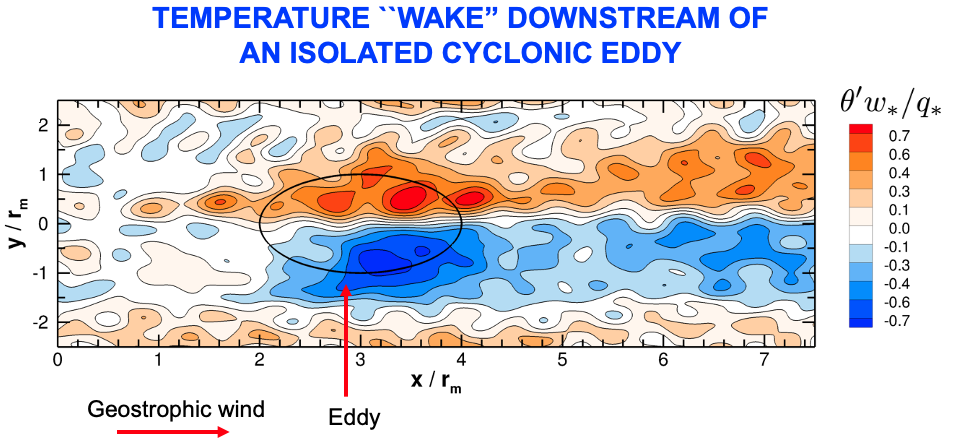Nels Nelson Memorial Fellowship with Distinguished Lecture by Prof. Peter Sullivan
Join us on Tuesday, May 2nd at 3pm for a celebration of the 2023 Nels Nelson Memorial Fellowship recipient Noah Gallagher, with a distinguished lecture by Prof. Peter Sullivan.
Peter Sullivan, Senior Scientist in the Mesoscale and Microscale Laboratory at the National Center for Atmospheric Research and affiliate faculty in the Civil Engineering Department at Colorado State University
Distinguished lecture: Marine boundary layers coupled to ocean surface heterogeneity: Secondary circulations in LES process studies
Abstract: Numerical simulations of the atmospheric boundary layer often adopt a horizontally homogeneous lower boundary - a simplifying assumption that is seldom if ever found in nature. Field observations are collected above spatially varying land and ocean surfaces, and then surface heterogeneity is a source of uncertainty when comparing simulations and observations. The ocean surface in particular features high spatial variability in sea surface temperature (SST), currents, and surface waves over a broad range of horizontal scales. The present work uses large-eddy simulation (LES) to examine the impact of heterogeneous SST on the marine atmospheric boundary layer. The imposed heterogeneity is a single-sided warm or cold front with temperature jumps varying over a horizontal distance between $[0.1 - 6]$\,km characteristic of an upper ocean mesoscale or submesoscale regime. A specially designed numerical Fourier-fringe technique is implemented in the LES to overcome the usual assumptions of horizontally homogeneous periodic flow. The winds oriented across (or perpendicular) to the fronts develop secondary circulations with rotation varying with the sign of the front. Warm fronts feature overshoots in the temperature field, non-linear temperature and momentum fluxes, a local maximum in the vertical velocity variance and an extended spatial evolution of the boundary layer with increasing distance from the SST front.

Large eddy simulation (LES) is also used to elucidate eddy impacts on the atmospheric boundary layer (ABL) forced by winds, convection, and an eddy with varying radius; the maximum azimuthal eddy speed is 1\,m\,s$^{-1}$. Simulations span the unstable regime $-1/L = [0, \infty]$ where $L$ is the Monin-Obukhov (M-O) stability parameter. Eddy currents induce a surface stress anomaly that induces Ekman pumping in a dipole horizontal pattern. The dipole is understood as a consequence of surface winds aligned or opposing surface currents. In free convection a vigorous updraft is found above the eddy center and persists over the ABL depth. With winds and convection, current stress coupling also generates a dipole in surface temperature flux even with constant sea surface temperature. Wind, pressure, and temperature anomalies are most sensitive to an eddy under light winds. Flow over an isolated eddy develops a coherent ABL "wake" and secondary circulations downwind. Kinetic energy exchanges by wind-work indicate an eddy-killing effect on the oceanic eddy current, but only a spatial rearrangement of the atmospheric wind-work.
About: Peter Sullivan is a Senior Scientist in the Mesoscale and Microscale Laboratory at the National Center for Atmospheric Research and an affiliate faculty in the Civil Engineering Department at Colorado State University. Peter received his Bachelor's and Ph.D Degrees in Civil Engineering from Colorado State University and a Master's Degree in Mechanical Engineering from University of British Columbia. Prior to coming to NCAR, Peter worked for six years as a Senior Specialist Engineer in Aerodynamics Research at the Boeing Company where he worked on shock/boundary-layer interaction, drag reducing riblets, and the design of the 777 transonic airplane.
Peter's research interests at NCAR are: simulations and measurements of geophysical turbulence, subgrid-scale modeling, air-sea interaction, effects of surface gravity waves on marine boundary layers, submesoscale turbulence in the upper ocean, impacts of stratification, turbulent flow over hills, and numerical methods. He uses large-eddy and direct numerical simulations to investigate turbulent processes in both the atmospheric boundary layer and the ocean mixed layer. These turbulence simulation codes run on large parallel supercomputers. Peter has participated in and planned field campaigns, Horizontal Array Turbulence Study, Ocean Horizontal Array Turbulence Study, and Canopy Horizontal Array Turbulence Study focused on the measurement of subgrid scale variables in the atmospheric surface layer.
2023 Nels Nelson Memorial Fellowship recipient Noah Gallagher, advised by Prof. John Gulliver
Presentation title: Assessing Stormwater Adaptations for Extreme Rainfall Events
Abstract: Extreme rainfall events in recent decades are more frequent and intense. The increase in precipitation has large ramifications for urban landscape design, stormwater runoff management, and flood control. This presentation will share the final results and recommendations of a research project: Climate Change Adaptation of Urban Stormwater Infrastructure, funded by the Local Road Research Board (LRRB) of MN, which evaluated several different stormwater management strategies and their effectiveness in the face of climate driven extreme rainfall events. The strategies include upsizing storm sewer pipes, adding wet ponds, retrofitting existing stormwater ponds to be “smart” ponds, adding rain gardens, and others. In order to evaluate the efficacy of a strategy, the project team used the U.S. EPA’s SWMM software to model adaptations to three Minnesota watersheds for a variety of rainfall depths and return periods. The cost of adaptations was also considered, leveraging data from the Water Research Foundation’s “Community-enabled Lifecycle Analysis of Stormwater Infrastructure Costs” (CLASIC). With these research results, stormwater managers can compare and contrast different adaptation strategies to aid their decision making when updating and adapting their stormwater management systems.

About: Noah Gallagher is a Ph.D. student in the Department of Civil, Environmental and Geo-Engineering working with the Stormwater Research Group led by Dr. John Gulliver at St. Anthony Falls Laboratory. His research focuses on modeling extreme precipitation events, particular future events that have been enlarged by climate change. This work aims to better link watershed models to observable landscape characteristics and use results of those models to recommend the most cost effective methods for adapting to these large return interval events. Prior to starting graduate work, Noah received his Bachelors of Environmental Engineering from the University of Minnesota, where he worked with SAFL's Stormwater Group and CEGE's Novak Lab on laboratory and field measurements for a variety of projects.
